University Nutrition Report: Calcium Intake in Australian Population
VerifiedAdded on 2022/10/17
|12
|3574
|40
Report
AI Summary
This report, submitted by a student and available on Desklib, provides a comprehensive analysis of calcium intake within the Australian population, focusing on data from the 2011-12 National Nutrition and Physical Activity Survey. The report is divided into three parts: Part A evaluates population-based dietary data, detailing the methods used for data collection, interpretation, and the identification of associated health risks, particularly calcium deficiency. Part B addresses an audio transcript, and Part C offers a reflection on the learning outcomes. The study explores the calcium intake levels across different age and gender groups, identifies health risks such as osteoporosis and rickets, and proposes relevant solutions, including dietary modifications like increased consumption of dairy products, green leafy vegetables, and the reduction of factors inhibiting calcium absorption, such as caffeine and alcohol, to improve health outcomes. The report emphasizes the importance of calcium for bone and teeth development, muscle control, and blood circulation, highlighting the need for adequate calcium intake to prevent related health issues.
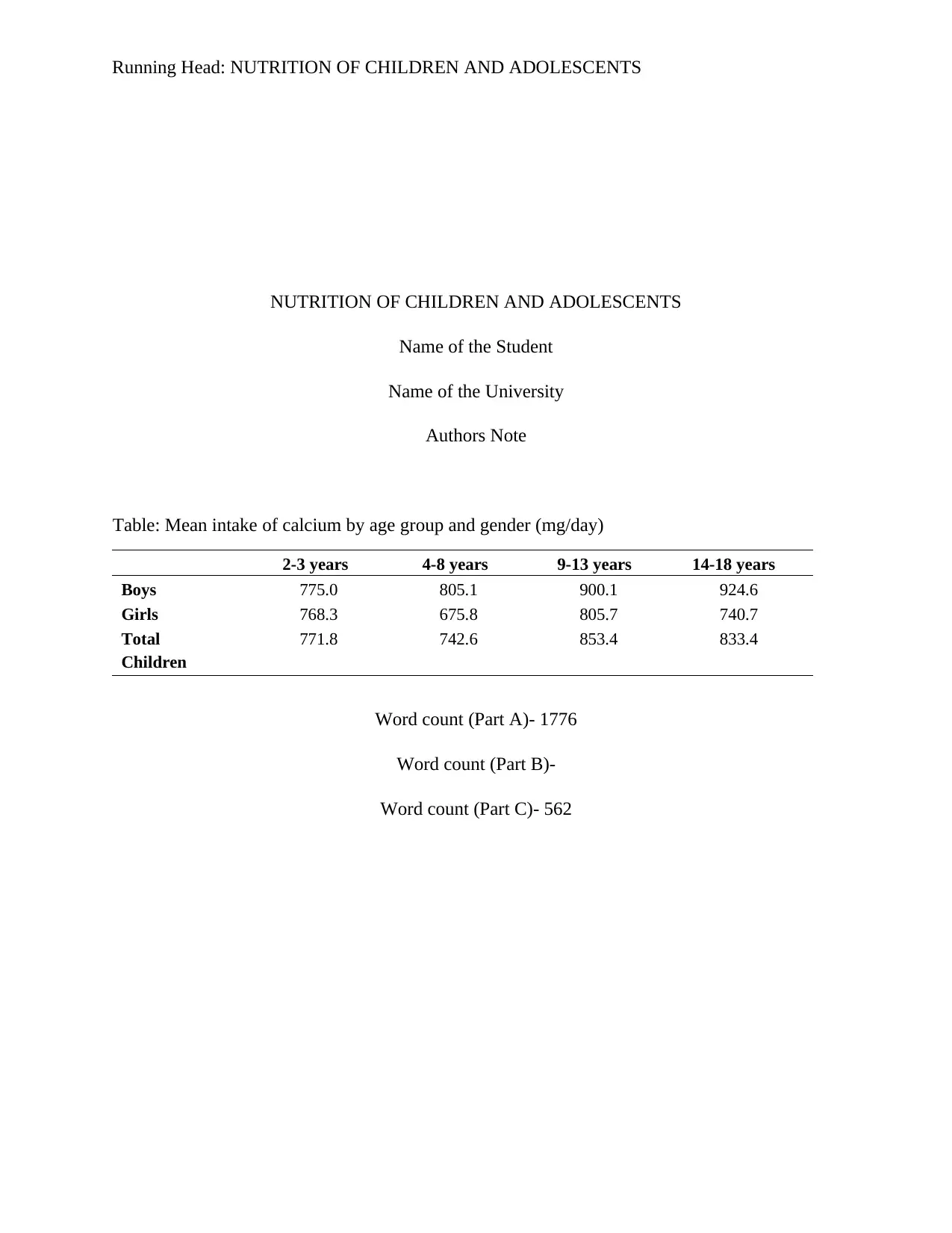
Running Head: NUTRITION OF CHILDREN AND ADOLESCENTS
NUTRITION OF CHILDREN AND ADOLESCENTS
Name of the Student
Name of the University
Authors Note
Table: Mean intake of calcium by age group and gender (mg/day)
2-3 years 4-8 years 9-13 years 14-18 years
Boys 775.0 805.1 900.1 924.6
Girls 768.3 675.8 805.7 740.7
Total
Children
771.8 742.6 853.4 833.4
Word count (Part A)- 1776
Word count (Part B)-
Word count (Part C)- 562
NUTRITION OF CHILDREN AND ADOLESCENTS
Name of the Student
Name of the University
Authors Note
Table: Mean intake of calcium by age group and gender (mg/day)
2-3 years 4-8 years 9-13 years 14-18 years
Boys 775.0 805.1 900.1 924.6
Girls 768.3 675.8 805.7 740.7
Total
Children
771.8 742.6 853.4 833.4
Word count (Part A)- 1776
Word count (Part B)-
Word count (Part C)- 562
Paraphrase This Document
Need a fresh take? Get an instant paraphrase of this document with our AI Paraphraser
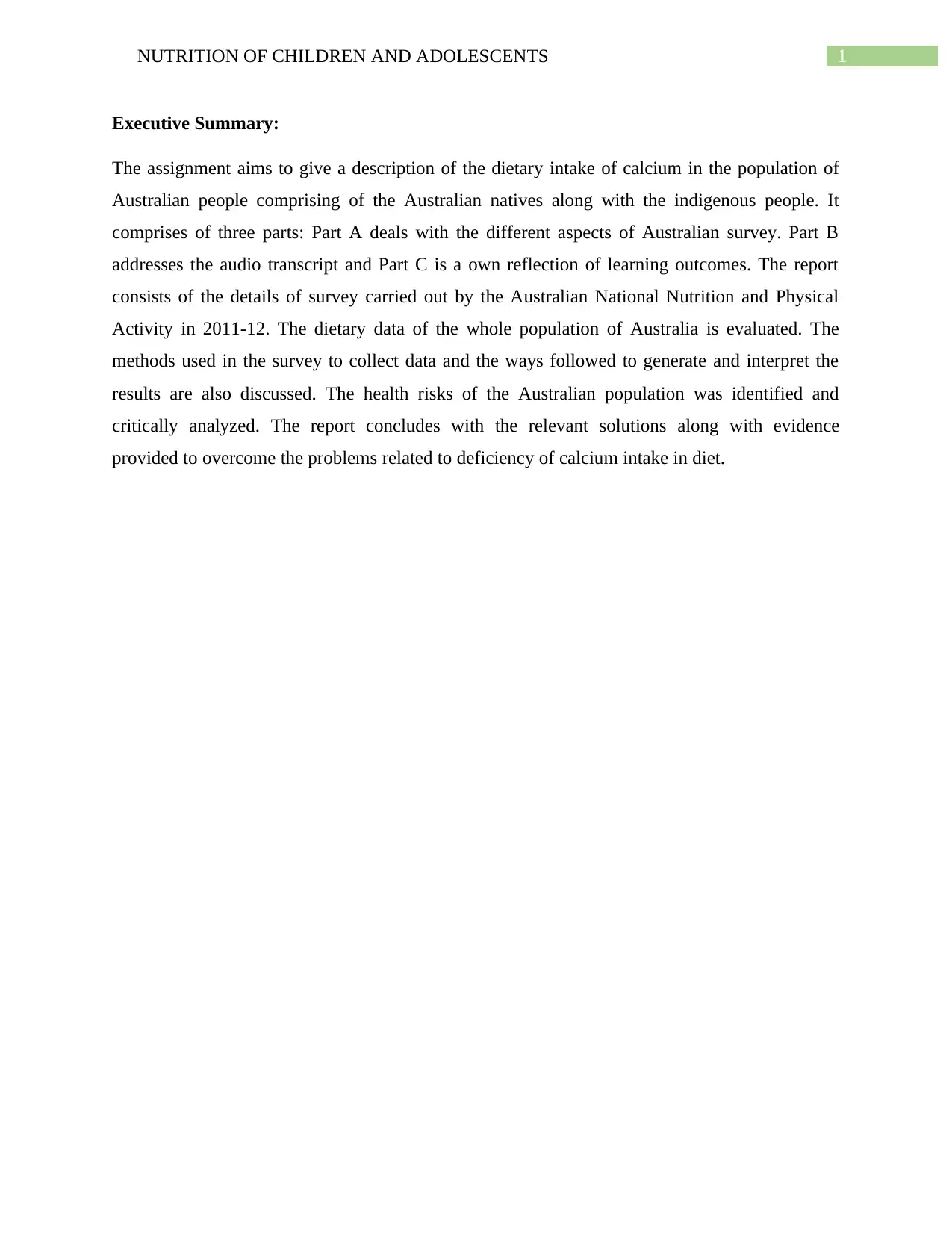
1NUTRITION OF CHILDREN AND ADOLESCENTS
Executive Summary:
The assignment aims to give a description of the dietary intake of calcium in the population of
Australian people comprising of the Australian natives along with the indigenous people. It
comprises of three parts: Part A deals with the different aspects of Australian survey. Part B
addresses the audio transcript and Part C is a own reflection of learning outcomes. The report
consists of the details of survey carried out by the Australian National Nutrition and Physical
Activity in 2011-12. The dietary data of the whole population of Australia is evaluated. The
methods used in the survey to collect data and the ways followed to generate and interpret the
results are also discussed. The health risks of the Australian population was identified and
critically analyzed. The report concludes with the relevant solutions along with evidence
provided to overcome the problems related to deficiency of calcium intake in diet.
Executive Summary:
The assignment aims to give a description of the dietary intake of calcium in the population of
Australian people comprising of the Australian natives along with the indigenous people. It
comprises of three parts: Part A deals with the different aspects of Australian survey. Part B
addresses the audio transcript and Part C is a own reflection of learning outcomes. The report
consists of the details of survey carried out by the Australian National Nutrition and Physical
Activity in 2011-12. The dietary data of the whole population of Australia is evaluated. The
methods used in the survey to collect data and the ways followed to generate and interpret the
results are also discussed. The health risks of the Australian population was identified and
critically analyzed. The report concludes with the relevant solutions along with evidence
provided to overcome the problems related to deficiency of calcium intake in diet.
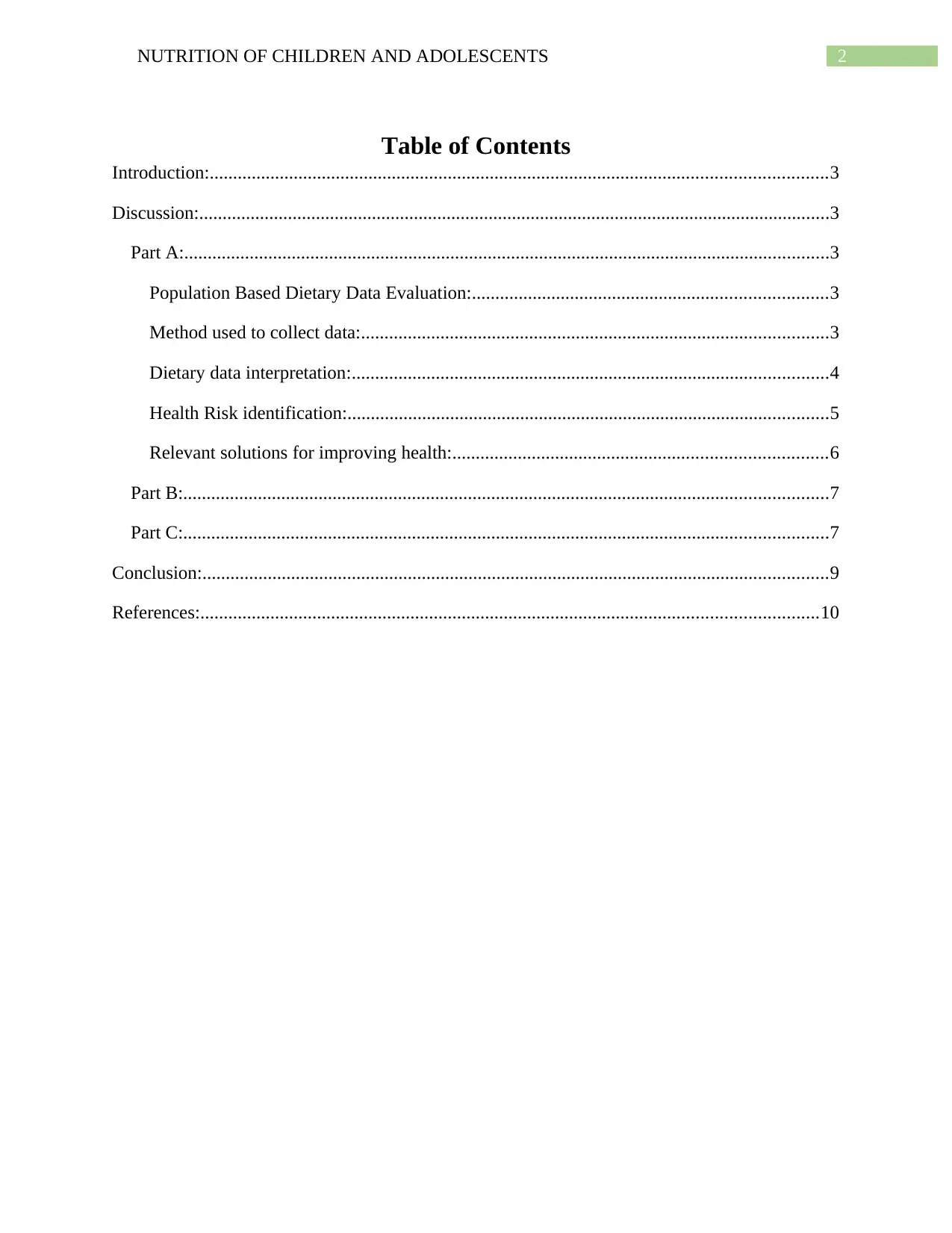
2NUTRITION OF CHILDREN AND ADOLESCENTS
Table of Contents
Introduction:....................................................................................................................................3
Discussion:.......................................................................................................................................3
Part A:..........................................................................................................................................3
Population Based Dietary Data Evaluation:............................................................................3
Method used to collect data:....................................................................................................3
Dietary data interpretation:......................................................................................................4
Health Risk identification:.......................................................................................................5
Relevant solutions for improving health:................................................................................6
Part B:..........................................................................................................................................7
Part C:..........................................................................................................................................7
Conclusion:......................................................................................................................................9
References:....................................................................................................................................10
Table of Contents
Introduction:....................................................................................................................................3
Discussion:.......................................................................................................................................3
Part A:..........................................................................................................................................3
Population Based Dietary Data Evaluation:............................................................................3
Method used to collect data:....................................................................................................3
Dietary data interpretation:......................................................................................................4
Health Risk identification:.......................................................................................................5
Relevant solutions for improving health:................................................................................6
Part B:..........................................................................................................................................7
Part C:..........................................................................................................................................7
Conclusion:......................................................................................................................................9
References:....................................................................................................................................10
⊘ This is a preview!⊘
Do you want full access?
Subscribe today to unlock all pages.

Trusted by 1+ million students worldwide
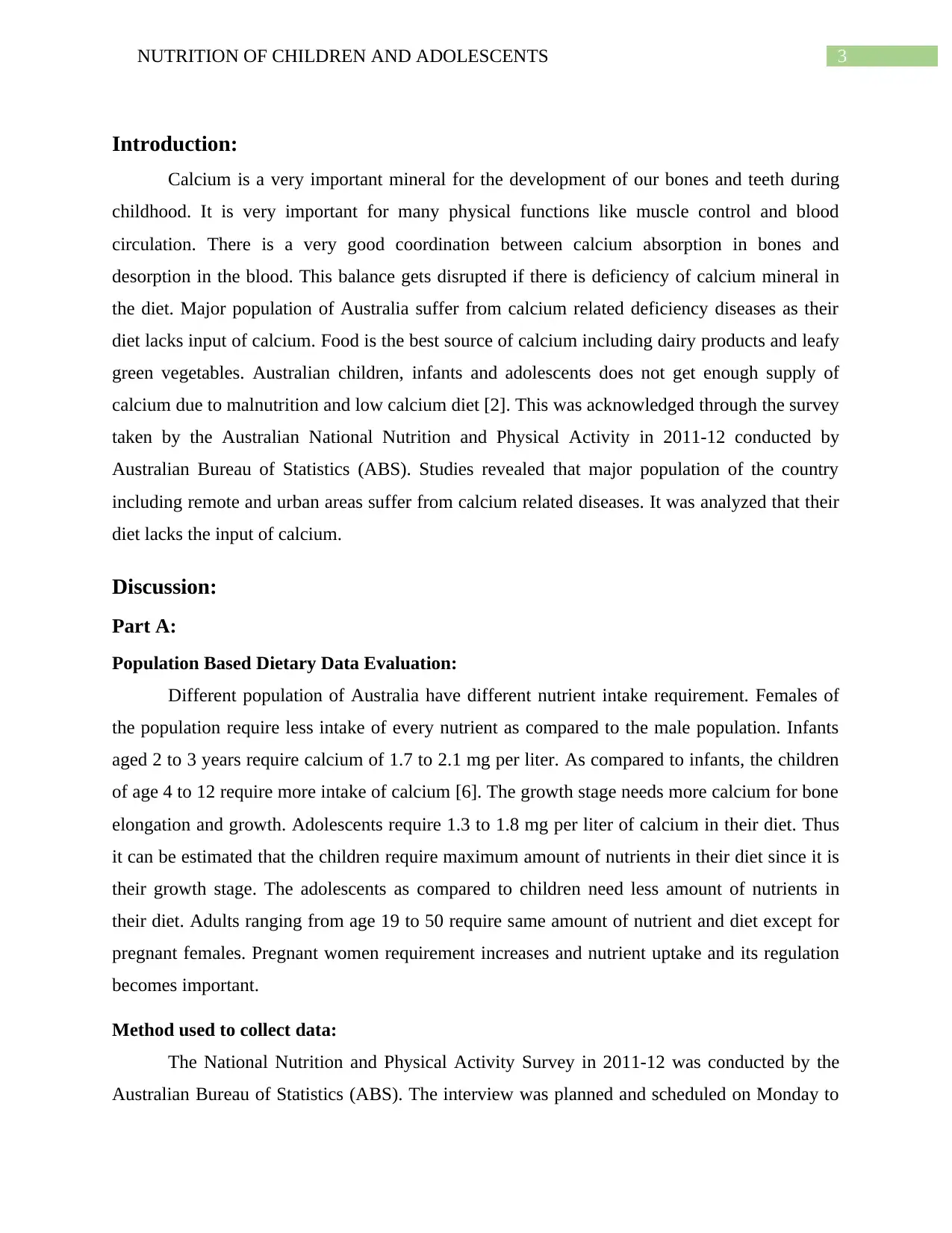
3NUTRITION OF CHILDREN AND ADOLESCENTS
Introduction:
Calcium is a very important mineral for the development of our bones and teeth during
childhood. It is very important for many physical functions like muscle control and blood
circulation. There is a very good coordination between calcium absorption in bones and
desorption in the blood. This balance gets disrupted if there is deficiency of calcium mineral in
the diet. Major population of Australia suffer from calcium related deficiency diseases as their
diet lacks input of calcium. Food is the best source of calcium including dairy products and leafy
green vegetables. Australian children, infants and adolescents does not get enough supply of
calcium due to malnutrition and low calcium diet [2]. This was acknowledged through the survey
taken by the Australian National Nutrition and Physical Activity in 2011-12 conducted by
Australian Bureau of Statistics (ABS). Studies revealed that major population of the country
including remote and urban areas suffer from calcium related diseases. It was analyzed that their
diet lacks the input of calcium.
Discussion:
Part A:
Population Based Dietary Data Evaluation:
Different population of Australia have different nutrient intake requirement. Females of
the population require less intake of every nutrient as compared to the male population. Infants
aged 2 to 3 years require calcium of 1.7 to 2.1 mg per liter. As compared to infants, the children
of age 4 to 12 require more intake of calcium [6]. The growth stage needs more calcium for bone
elongation and growth. Adolescents require 1.3 to 1.8 mg per liter of calcium in their diet. Thus
it can be estimated that the children require maximum amount of nutrients in their diet since it is
their growth stage. The adolescents as compared to children need less amount of nutrients in
their diet. Adults ranging from age 19 to 50 require same amount of nutrient and diet except for
pregnant females. Pregnant women requirement increases and nutrient uptake and its regulation
becomes important.
Method used to collect data:
The National Nutrition and Physical Activity Survey in 2011-12 was conducted by the
Australian Bureau of Statistics (ABS). The interview was planned and scheduled on Monday to
Introduction:
Calcium is a very important mineral for the development of our bones and teeth during
childhood. It is very important for many physical functions like muscle control and blood
circulation. There is a very good coordination between calcium absorption in bones and
desorption in the blood. This balance gets disrupted if there is deficiency of calcium mineral in
the diet. Major population of Australia suffer from calcium related deficiency diseases as their
diet lacks input of calcium. Food is the best source of calcium including dairy products and leafy
green vegetables. Australian children, infants and adolescents does not get enough supply of
calcium due to malnutrition and low calcium diet [2]. This was acknowledged through the survey
taken by the Australian National Nutrition and Physical Activity in 2011-12 conducted by
Australian Bureau of Statistics (ABS). Studies revealed that major population of the country
including remote and urban areas suffer from calcium related diseases. It was analyzed that their
diet lacks the input of calcium.
Discussion:
Part A:
Population Based Dietary Data Evaluation:
Different population of Australia have different nutrient intake requirement. Females of
the population require less intake of every nutrient as compared to the male population. Infants
aged 2 to 3 years require calcium of 1.7 to 2.1 mg per liter. As compared to infants, the children
of age 4 to 12 require more intake of calcium [6]. The growth stage needs more calcium for bone
elongation and growth. Adolescents require 1.3 to 1.8 mg per liter of calcium in their diet. Thus
it can be estimated that the children require maximum amount of nutrients in their diet since it is
their growth stage. The adolescents as compared to children need less amount of nutrients in
their diet. Adults ranging from age 19 to 50 require same amount of nutrient and diet except for
pregnant females. Pregnant women requirement increases and nutrient uptake and its regulation
becomes important.
Method used to collect data:
The National Nutrition and Physical Activity Survey in 2011-12 was conducted by the
Australian Bureau of Statistics (ABS). The interview was planned and scheduled on Monday to
Paraphrase This Document
Need a fresh take? Get an instant paraphrase of this document with our AI Paraphraser
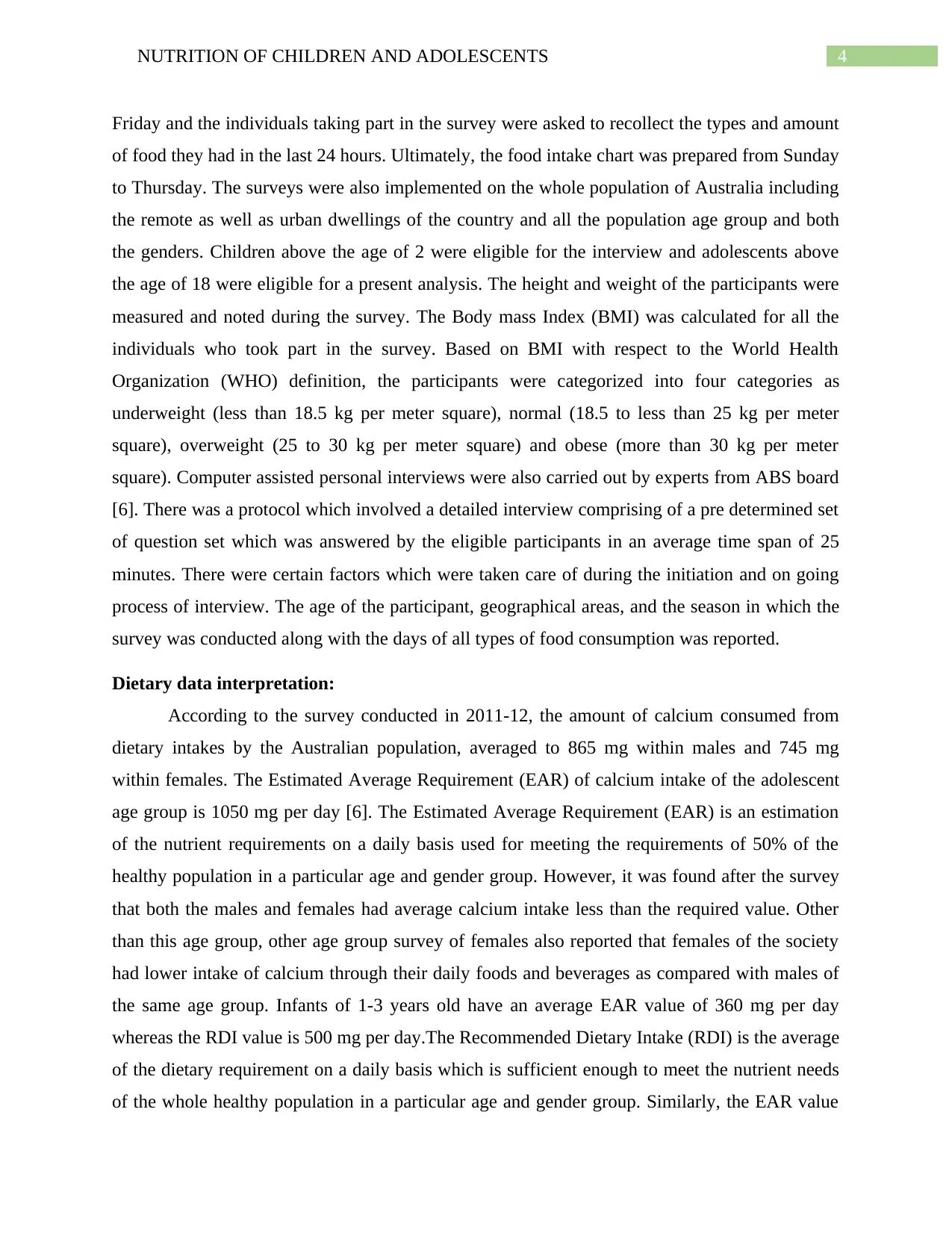
4NUTRITION OF CHILDREN AND ADOLESCENTS
Friday and the individuals taking part in the survey were asked to recollect the types and amount
of food they had in the last 24 hours. Ultimately, the food intake chart was prepared from Sunday
to Thursday. The surveys were also implemented on the whole population of Australia including
the remote as well as urban dwellings of the country and all the population age group and both
the genders. Children above the age of 2 were eligible for the interview and adolescents above
the age of 18 were eligible for a present analysis. The height and weight of the participants were
measured and noted during the survey. The Body mass Index (BMI) was calculated for all the
individuals who took part in the survey. Based on BMI with respect to the World Health
Organization (WHO) definition, the participants were categorized into four categories as
underweight (less than 18.5 kg per meter square), normal (18.5 to less than 25 kg per meter
square), overweight (25 to 30 kg per meter square) and obese (more than 30 kg per meter
square). Computer assisted personal interviews were also carried out by experts from ABS board
[6]. There was a protocol which involved a detailed interview comprising of a pre determined set
of question set which was answered by the eligible participants in an average time span of 25
minutes. There were certain factors which were taken care of during the initiation and on going
process of interview. The age of the participant, geographical areas, and the season in which the
survey was conducted along with the days of all types of food consumption was reported.
Dietary data interpretation:
According to the survey conducted in 2011-12, the amount of calcium consumed from
dietary intakes by the Australian population, averaged to 865 mg within males and 745 mg
within females. The Estimated Average Requirement (EAR) of calcium intake of the adolescent
age group is 1050 mg per day [6]. The Estimated Average Requirement (EAR) is an estimation
of the nutrient requirements on a daily basis used for meeting the requirements of 50% of the
healthy population in a particular age and gender group. However, it was found after the survey
that both the males and females had average calcium intake less than the required value. Other
than this age group, other age group survey of females also reported that females of the society
had lower intake of calcium through their daily foods and beverages as compared with males of
the same age group. Infants of 1-3 years old have an average EAR value of 360 mg per day
whereas the RDI value is 500 mg per day.The Recommended Dietary Intake (RDI) is the average
of the dietary requirement on a daily basis which is sufficient enough to meet the nutrient needs
of the whole healthy population in a particular age and gender group. Similarly, the EAR value
Friday and the individuals taking part in the survey were asked to recollect the types and amount
of food they had in the last 24 hours. Ultimately, the food intake chart was prepared from Sunday
to Thursday. The surveys were also implemented on the whole population of Australia including
the remote as well as urban dwellings of the country and all the population age group and both
the genders. Children above the age of 2 were eligible for the interview and adolescents above
the age of 18 were eligible for a present analysis. The height and weight of the participants were
measured and noted during the survey. The Body mass Index (BMI) was calculated for all the
individuals who took part in the survey. Based on BMI with respect to the World Health
Organization (WHO) definition, the participants were categorized into four categories as
underweight (less than 18.5 kg per meter square), normal (18.5 to less than 25 kg per meter
square), overweight (25 to 30 kg per meter square) and obese (more than 30 kg per meter
square). Computer assisted personal interviews were also carried out by experts from ABS board
[6]. There was a protocol which involved a detailed interview comprising of a pre determined set
of question set which was answered by the eligible participants in an average time span of 25
minutes. There were certain factors which were taken care of during the initiation and on going
process of interview. The age of the participant, geographical areas, and the season in which the
survey was conducted along with the days of all types of food consumption was reported.
Dietary data interpretation:
According to the survey conducted in 2011-12, the amount of calcium consumed from
dietary intakes by the Australian population, averaged to 865 mg within males and 745 mg
within females. The Estimated Average Requirement (EAR) of calcium intake of the adolescent
age group is 1050 mg per day [6]. The Estimated Average Requirement (EAR) is an estimation
of the nutrient requirements on a daily basis used for meeting the requirements of 50% of the
healthy population in a particular age and gender group. However, it was found after the survey
that both the males and females had average calcium intake less than the required value. Other
than this age group, other age group survey of females also reported that females of the society
had lower intake of calcium through their daily foods and beverages as compared with males of
the same age group. Infants of 1-3 years old have an average EAR value of 360 mg per day
whereas the RDI value is 500 mg per day.The Recommended Dietary Intake (RDI) is the average
of the dietary requirement on a daily basis which is sufficient enough to meet the nutrient needs
of the whole healthy population in a particular age and gender group. Similarly, the EAR value
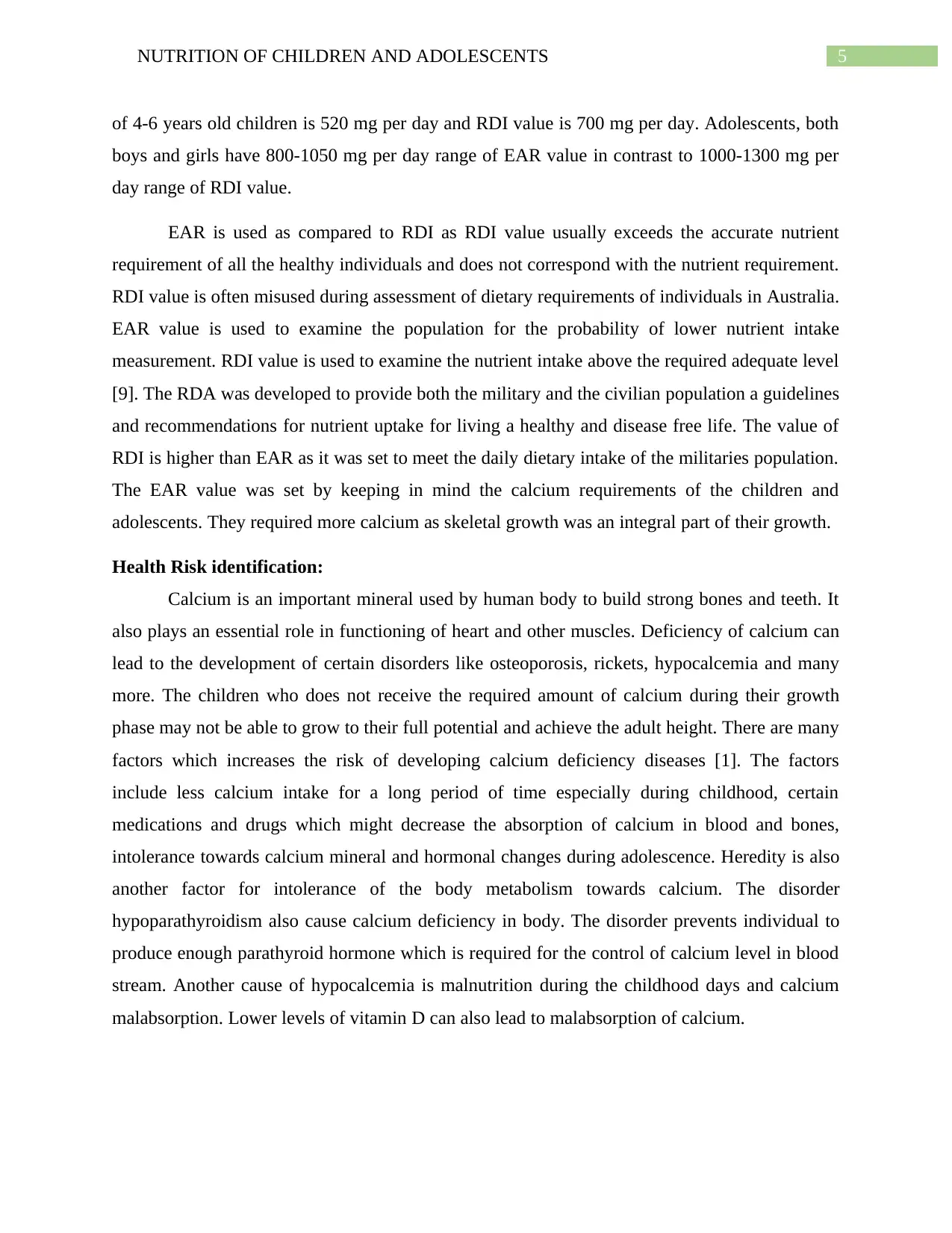
5NUTRITION OF CHILDREN AND ADOLESCENTS
of 4-6 years old children is 520 mg per day and RDI value is 700 mg per day. Adolescents, both
boys and girls have 800-1050 mg per day range of EAR value in contrast to 1000-1300 mg per
day range of RDI value.
EAR is used as compared to RDI as RDI value usually exceeds the accurate nutrient
requirement of all the healthy individuals and does not correspond with the nutrient requirement.
RDI value is often misused during assessment of dietary requirements of individuals in Australia.
EAR value is used to examine the population for the probability of lower nutrient intake
measurement. RDI value is used to examine the nutrient intake above the required adequate level
[9]. The RDA was developed to provide both the military and the civilian population a guidelines
and recommendations for nutrient uptake for living a healthy and disease free life. The value of
RDI is higher than EAR as it was set to meet the daily dietary intake of the militaries population.
The EAR value was set by keeping in mind the calcium requirements of the children and
adolescents. They required more calcium as skeletal growth was an integral part of their growth.
Health Risk identification:
Calcium is an important mineral used by human body to build strong bones and teeth. It
also plays an essential role in functioning of heart and other muscles. Deficiency of calcium can
lead to the development of certain disorders like osteoporosis, rickets, hypocalcemia and many
more. The children who does not receive the required amount of calcium during their growth
phase may not be able to grow to their full potential and achieve the adult height. There are many
factors which increases the risk of developing calcium deficiency diseases [1]. The factors
include less calcium intake for a long period of time especially during childhood, certain
medications and drugs which might decrease the absorption of calcium in blood and bones,
intolerance towards calcium mineral and hormonal changes during adolescence. Heredity is also
another factor for intolerance of the body metabolism towards calcium. The disorder
hypoparathyroidism also cause calcium deficiency in body. The disorder prevents individual to
produce enough parathyroid hormone which is required for the control of calcium level in blood
stream. Another cause of hypocalcemia is malnutrition during the childhood days and calcium
malabsorption. Lower levels of vitamin D can also lead to malabsorption of calcium.
of 4-6 years old children is 520 mg per day and RDI value is 700 mg per day. Adolescents, both
boys and girls have 800-1050 mg per day range of EAR value in contrast to 1000-1300 mg per
day range of RDI value.
EAR is used as compared to RDI as RDI value usually exceeds the accurate nutrient
requirement of all the healthy individuals and does not correspond with the nutrient requirement.
RDI value is often misused during assessment of dietary requirements of individuals in Australia.
EAR value is used to examine the population for the probability of lower nutrient intake
measurement. RDI value is used to examine the nutrient intake above the required adequate level
[9]. The RDA was developed to provide both the military and the civilian population a guidelines
and recommendations for nutrient uptake for living a healthy and disease free life. The value of
RDI is higher than EAR as it was set to meet the daily dietary intake of the militaries population.
The EAR value was set by keeping in mind the calcium requirements of the children and
adolescents. They required more calcium as skeletal growth was an integral part of their growth.
Health Risk identification:
Calcium is an important mineral used by human body to build strong bones and teeth. It
also plays an essential role in functioning of heart and other muscles. Deficiency of calcium can
lead to the development of certain disorders like osteoporosis, rickets, hypocalcemia and many
more. The children who does not receive the required amount of calcium during their growth
phase may not be able to grow to their full potential and achieve the adult height. There are many
factors which increases the risk of developing calcium deficiency diseases [1]. The factors
include less calcium intake for a long period of time especially during childhood, certain
medications and drugs which might decrease the absorption of calcium in blood and bones,
intolerance towards calcium mineral and hormonal changes during adolescence. Heredity is also
another factor for intolerance of the body metabolism towards calcium. The disorder
hypoparathyroidism also cause calcium deficiency in body. The disorder prevents individual to
produce enough parathyroid hormone which is required for the control of calcium level in blood
stream. Another cause of hypocalcemia is malnutrition during the childhood days and calcium
malabsorption. Lower levels of vitamin D can also lead to malabsorption of calcium.
⊘ This is a preview!⊘
Do you want full access?
Subscribe today to unlock all pages.

Trusted by 1+ million students worldwide
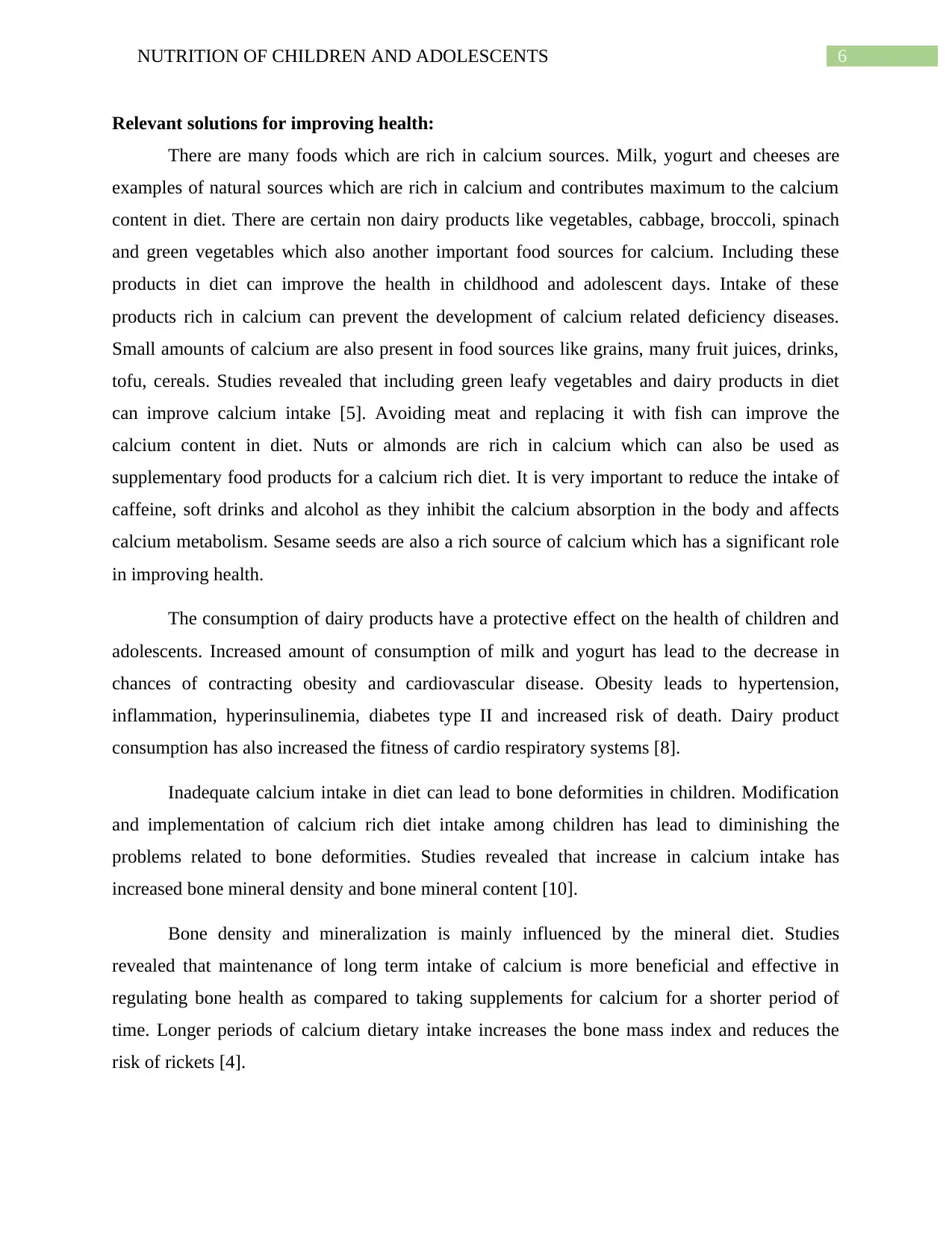
6NUTRITION OF CHILDREN AND ADOLESCENTS
Relevant solutions for improving health:
There are many foods which are rich in calcium sources. Milk, yogurt and cheeses are
examples of natural sources which are rich in calcium and contributes maximum to the calcium
content in diet. There are certain non dairy products like vegetables, cabbage, broccoli, spinach
and green vegetables which also another important food sources for calcium. Including these
products in diet can improve the health in childhood and adolescent days. Intake of these
products rich in calcium can prevent the development of calcium related deficiency diseases.
Small amounts of calcium are also present in food sources like grains, many fruit juices, drinks,
tofu, cereals. Studies revealed that including green leafy vegetables and dairy products in diet
can improve calcium intake [5]. Avoiding meat and replacing it with fish can improve the
calcium content in diet. Nuts or almonds are rich in calcium which can also be used as
supplementary food products for a calcium rich diet. It is very important to reduce the intake of
caffeine, soft drinks and alcohol as they inhibit the calcium absorption in the body and affects
calcium metabolism. Sesame seeds are also a rich source of calcium which has a significant role
in improving health.
The consumption of dairy products have a protective effect on the health of children and
adolescents. Increased amount of consumption of milk and yogurt has lead to the decrease in
chances of contracting obesity and cardiovascular disease. Obesity leads to hypertension,
inflammation, hyperinsulinemia, diabetes type II and increased risk of death. Dairy product
consumption has also increased the fitness of cardio respiratory systems [8].
Inadequate calcium intake in diet can lead to bone deformities in children. Modification
and implementation of calcium rich diet intake among children has lead to diminishing the
problems related to bone deformities. Studies revealed that increase in calcium intake has
increased bone mineral density and bone mineral content [10].
Bone density and mineralization is mainly influenced by the mineral diet. Studies
revealed that maintenance of long term intake of calcium is more beneficial and effective in
regulating bone health as compared to taking supplements for calcium for a shorter period of
time. Longer periods of calcium dietary intake increases the bone mass index and reduces the
risk of rickets [4].
Relevant solutions for improving health:
There are many foods which are rich in calcium sources. Milk, yogurt and cheeses are
examples of natural sources which are rich in calcium and contributes maximum to the calcium
content in diet. There are certain non dairy products like vegetables, cabbage, broccoli, spinach
and green vegetables which also another important food sources for calcium. Including these
products in diet can improve the health in childhood and adolescent days. Intake of these
products rich in calcium can prevent the development of calcium related deficiency diseases.
Small amounts of calcium are also present in food sources like grains, many fruit juices, drinks,
tofu, cereals. Studies revealed that including green leafy vegetables and dairy products in diet
can improve calcium intake [5]. Avoiding meat and replacing it with fish can improve the
calcium content in diet. Nuts or almonds are rich in calcium which can also be used as
supplementary food products for a calcium rich diet. It is very important to reduce the intake of
caffeine, soft drinks and alcohol as they inhibit the calcium absorption in the body and affects
calcium metabolism. Sesame seeds are also a rich source of calcium which has a significant role
in improving health.
The consumption of dairy products have a protective effect on the health of children and
adolescents. Increased amount of consumption of milk and yogurt has lead to the decrease in
chances of contracting obesity and cardiovascular disease. Obesity leads to hypertension,
inflammation, hyperinsulinemia, diabetes type II and increased risk of death. Dairy product
consumption has also increased the fitness of cardio respiratory systems [8].
Inadequate calcium intake in diet can lead to bone deformities in children. Modification
and implementation of calcium rich diet intake among children has lead to diminishing the
problems related to bone deformities. Studies revealed that increase in calcium intake has
increased bone mineral density and bone mineral content [10].
Bone density and mineralization is mainly influenced by the mineral diet. Studies
revealed that maintenance of long term intake of calcium is more beneficial and effective in
regulating bone health as compared to taking supplements for calcium for a shorter period of
time. Longer periods of calcium dietary intake increases the bone mass index and reduces the
risk of rickets [4].
Paraphrase This Document
Need a fresh take? Get an instant paraphrase of this document with our AI Paraphraser
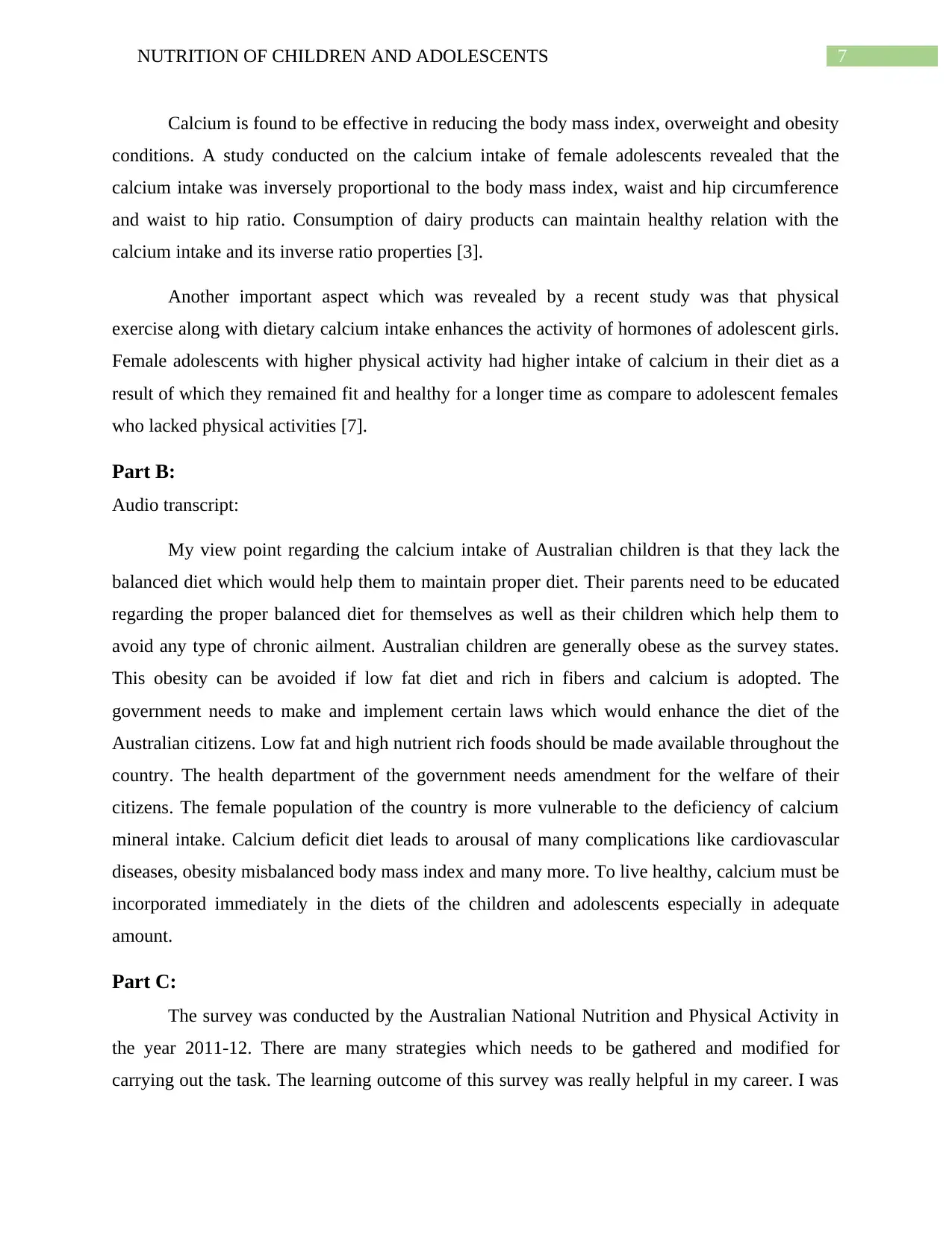
7NUTRITION OF CHILDREN AND ADOLESCENTS
Calcium is found to be effective in reducing the body mass index, overweight and obesity
conditions. A study conducted on the calcium intake of female adolescents revealed that the
calcium intake was inversely proportional to the body mass index, waist and hip circumference
and waist to hip ratio. Consumption of dairy products can maintain healthy relation with the
calcium intake and its inverse ratio properties [3].
Another important aspect which was revealed by a recent study was that physical
exercise along with dietary calcium intake enhances the activity of hormones of adolescent girls.
Female adolescents with higher physical activity had higher intake of calcium in their diet as a
result of which they remained fit and healthy for a longer time as compare to adolescent females
who lacked physical activities [7].
Part B:
Audio transcript:
My view point regarding the calcium intake of Australian children is that they lack the
balanced diet which would help them to maintain proper diet. Their parents need to be educated
regarding the proper balanced diet for themselves as well as their children which help them to
avoid any type of chronic ailment. Australian children are generally obese as the survey states.
This obesity can be avoided if low fat diet and rich in fibers and calcium is adopted. The
government needs to make and implement certain laws which would enhance the diet of the
Australian citizens. Low fat and high nutrient rich foods should be made available throughout the
country. The health department of the government needs amendment for the welfare of their
citizens. The female population of the country is more vulnerable to the deficiency of calcium
mineral intake. Calcium deficit diet leads to arousal of many complications like cardiovascular
diseases, obesity misbalanced body mass index and many more. To live healthy, calcium must be
incorporated immediately in the diets of the children and adolescents especially in adequate
amount.
Part C:
The survey was conducted by the Australian National Nutrition and Physical Activity in
the year 2011-12. There are many strategies which needs to be gathered and modified for
carrying out the task. The learning outcome of this survey was really helpful in my career. I was
Calcium is found to be effective in reducing the body mass index, overweight and obesity
conditions. A study conducted on the calcium intake of female adolescents revealed that the
calcium intake was inversely proportional to the body mass index, waist and hip circumference
and waist to hip ratio. Consumption of dairy products can maintain healthy relation with the
calcium intake and its inverse ratio properties [3].
Another important aspect which was revealed by a recent study was that physical
exercise along with dietary calcium intake enhances the activity of hormones of adolescent girls.
Female adolescents with higher physical activity had higher intake of calcium in their diet as a
result of which they remained fit and healthy for a longer time as compare to adolescent females
who lacked physical activities [7].
Part B:
Audio transcript:
My view point regarding the calcium intake of Australian children is that they lack the
balanced diet which would help them to maintain proper diet. Their parents need to be educated
regarding the proper balanced diet for themselves as well as their children which help them to
avoid any type of chronic ailment. Australian children are generally obese as the survey states.
This obesity can be avoided if low fat diet and rich in fibers and calcium is adopted. The
government needs to make and implement certain laws which would enhance the diet of the
Australian citizens. Low fat and high nutrient rich foods should be made available throughout the
country. The health department of the government needs amendment for the welfare of their
citizens. The female population of the country is more vulnerable to the deficiency of calcium
mineral intake. Calcium deficit diet leads to arousal of many complications like cardiovascular
diseases, obesity misbalanced body mass index and many more. To live healthy, calcium must be
incorporated immediately in the diets of the children and adolescents especially in adequate
amount.
Part C:
The survey was conducted by the Australian National Nutrition and Physical Activity in
the year 2011-12. There are many strategies which needs to be gathered and modified for
carrying out the task. The learning outcome of this survey was really helpful in my career. I was
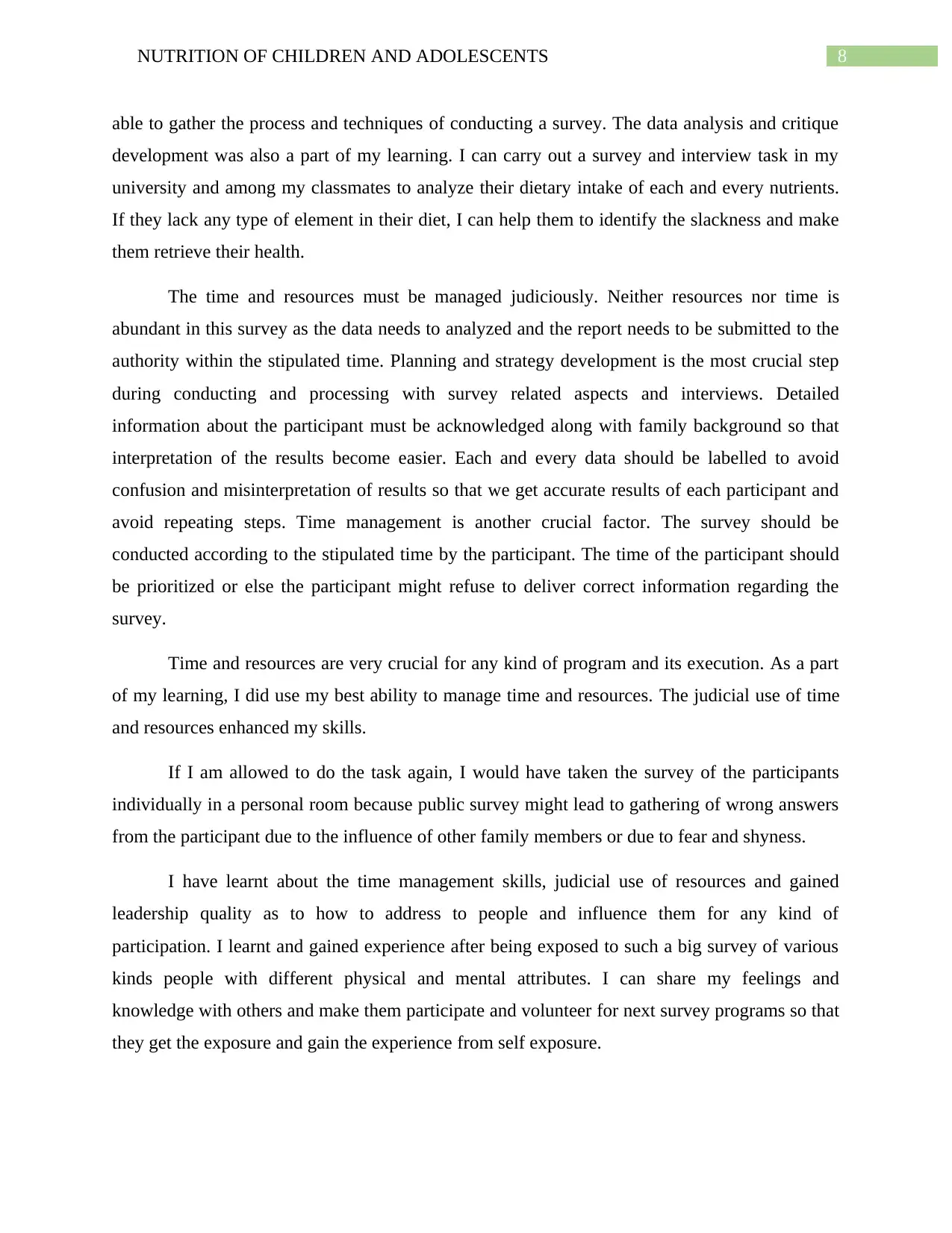
8NUTRITION OF CHILDREN AND ADOLESCENTS
able to gather the process and techniques of conducting a survey. The data analysis and critique
development was also a part of my learning. I can carry out a survey and interview task in my
university and among my classmates to analyze their dietary intake of each and every nutrients.
If they lack any type of element in their diet, I can help them to identify the slackness and make
them retrieve their health.
The time and resources must be managed judiciously. Neither resources nor time is
abundant in this survey as the data needs to analyzed and the report needs to be submitted to the
authority within the stipulated time. Planning and strategy development is the most crucial step
during conducting and processing with survey related aspects and interviews. Detailed
information about the participant must be acknowledged along with family background so that
interpretation of the results become easier. Each and every data should be labelled to avoid
confusion and misinterpretation of results so that we get accurate results of each participant and
avoid repeating steps. Time management is another crucial factor. The survey should be
conducted according to the stipulated time by the participant. The time of the participant should
be prioritized or else the participant might refuse to deliver correct information regarding the
survey.
Time and resources are very crucial for any kind of program and its execution. As a part
of my learning, I did use my best ability to manage time and resources. The judicial use of time
and resources enhanced my skills.
If I am allowed to do the task again, I would have taken the survey of the participants
individually in a personal room because public survey might lead to gathering of wrong answers
from the participant due to the influence of other family members or due to fear and shyness.
I have learnt about the time management skills, judicial use of resources and gained
leadership quality as to how to address to people and influence them for any kind of
participation. I learnt and gained experience after being exposed to such a big survey of various
kinds people with different physical and mental attributes. I can share my feelings and
knowledge with others and make them participate and volunteer for next survey programs so that
they get the exposure and gain the experience from self exposure.
able to gather the process and techniques of conducting a survey. The data analysis and critique
development was also a part of my learning. I can carry out a survey and interview task in my
university and among my classmates to analyze their dietary intake of each and every nutrients.
If they lack any type of element in their diet, I can help them to identify the slackness and make
them retrieve their health.
The time and resources must be managed judiciously. Neither resources nor time is
abundant in this survey as the data needs to analyzed and the report needs to be submitted to the
authority within the stipulated time. Planning and strategy development is the most crucial step
during conducting and processing with survey related aspects and interviews. Detailed
information about the participant must be acknowledged along with family background so that
interpretation of the results become easier. Each and every data should be labelled to avoid
confusion and misinterpretation of results so that we get accurate results of each participant and
avoid repeating steps. Time management is another crucial factor. The survey should be
conducted according to the stipulated time by the participant. The time of the participant should
be prioritized or else the participant might refuse to deliver correct information regarding the
survey.
Time and resources are very crucial for any kind of program and its execution. As a part
of my learning, I did use my best ability to manage time and resources. The judicial use of time
and resources enhanced my skills.
If I am allowed to do the task again, I would have taken the survey of the participants
individually in a personal room because public survey might lead to gathering of wrong answers
from the participant due to the influence of other family members or due to fear and shyness.
I have learnt about the time management skills, judicial use of resources and gained
leadership quality as to how to address to people and influence them for any kind of
participation. I learnt and gained experience after being exposed to such a big survey of various
kinds people with different physical and mental attributes. I can share my feelings and
knowledge with others and make them participate and volunteer for next survey programs so that
they get the exposure and gain the experience from self exposure.
⊘ This is a preview!⊘
Do you want full access?
Subscribe today to unlock all pages.

Trusted by 1+ million students worldwide
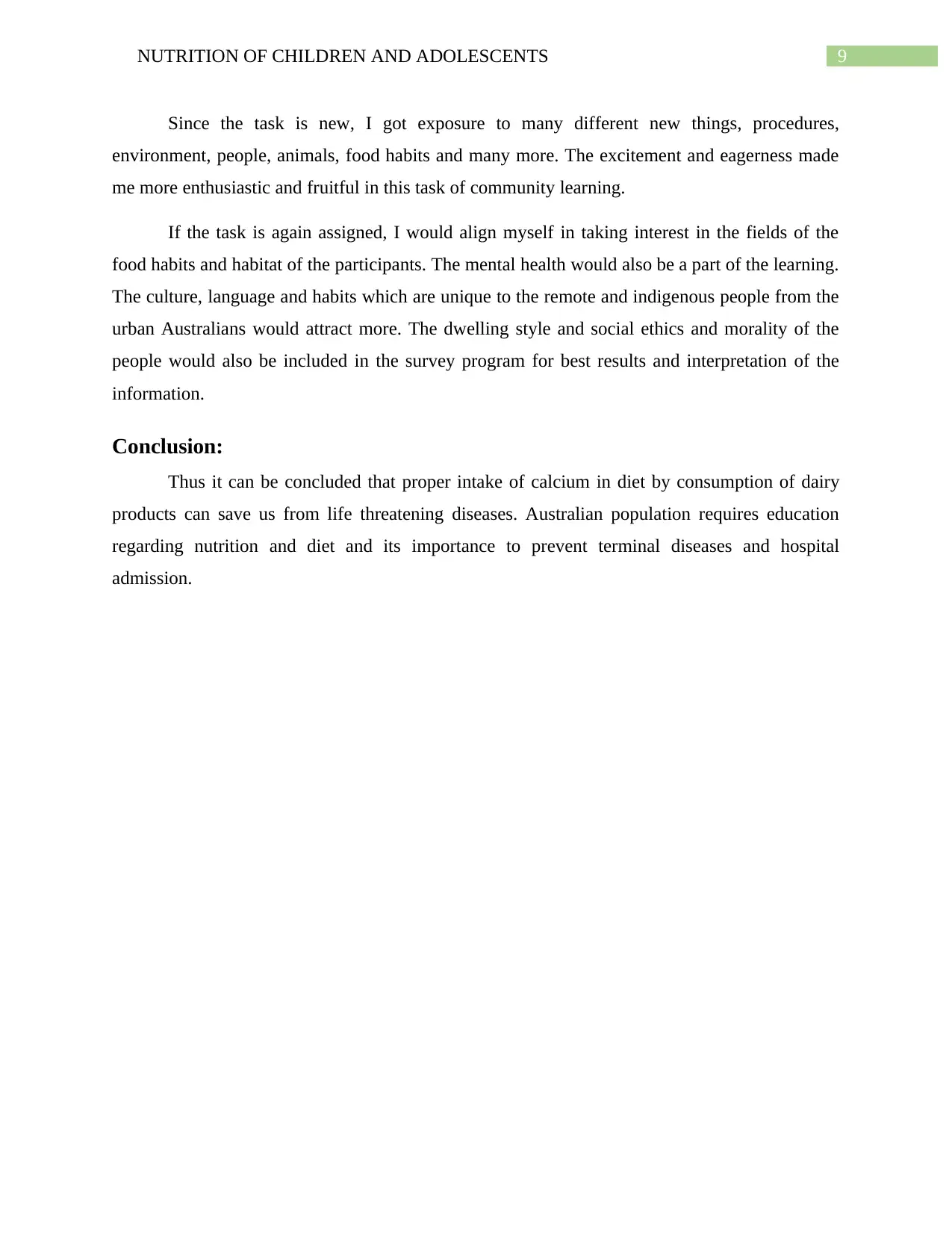
9NUTRITION OF CHILDREN AND ADOLESCENTS
Since the task is new, I got exposure to many different new things, procedures,
environment, people, animals, food habits and many more. The excitement and eagerness made
me more enthusiastic and fruitful in this task of community learning.
If the task is again assigned, I would align myself in taking interest in the fields of the
food habits and habitat of the participants. The mental health would also be a part of the learning.
The culture, language and habits which are unique to the remote and indigenous people from the
urban Australians would attract more. The dwelling style and social ethics and morality of the
people would also be included in the survey program for best results and interpretation of the
information.
Conclusion:
Thus it can be concluded that proper intake of calcium in diet by consumption of dairy
products can save us from life threatening diseases. Australian population requires education
regarding nutrition and diet and its importance to prevent terminal diseases and hospital
admission.
Since the task is new, I got exposure to many different new things, procedures,
environment, people, animals, food habits and many more. The excitement and eagerness made
me more enthusiastic and fruitful in this task of community learning.
If the task is again assigned, I would align myself in taking interest in the fields of the
food habits and habitat of the participants. The mental health would also be a part of the learning.
The culture, language and habits which are unique to the remote and indigenous people from the
urban Australians would attract more. The dwelling style and social ethics and morality of the
people would also be included in the survey program for best results and interpretation of the
information.
Conclusion:
Thus it can be concluded that proper intake of calcium in diet by consumption of dairy
products can save us from life threatening diseases. Australian population requires education
regarding nutrition and diet and its importance to prevent terminal diseases and hospital
admission.
Paraphrase This Document
Need a fresh take? Get an instant paraphrase of this document with our AI Paraphraser
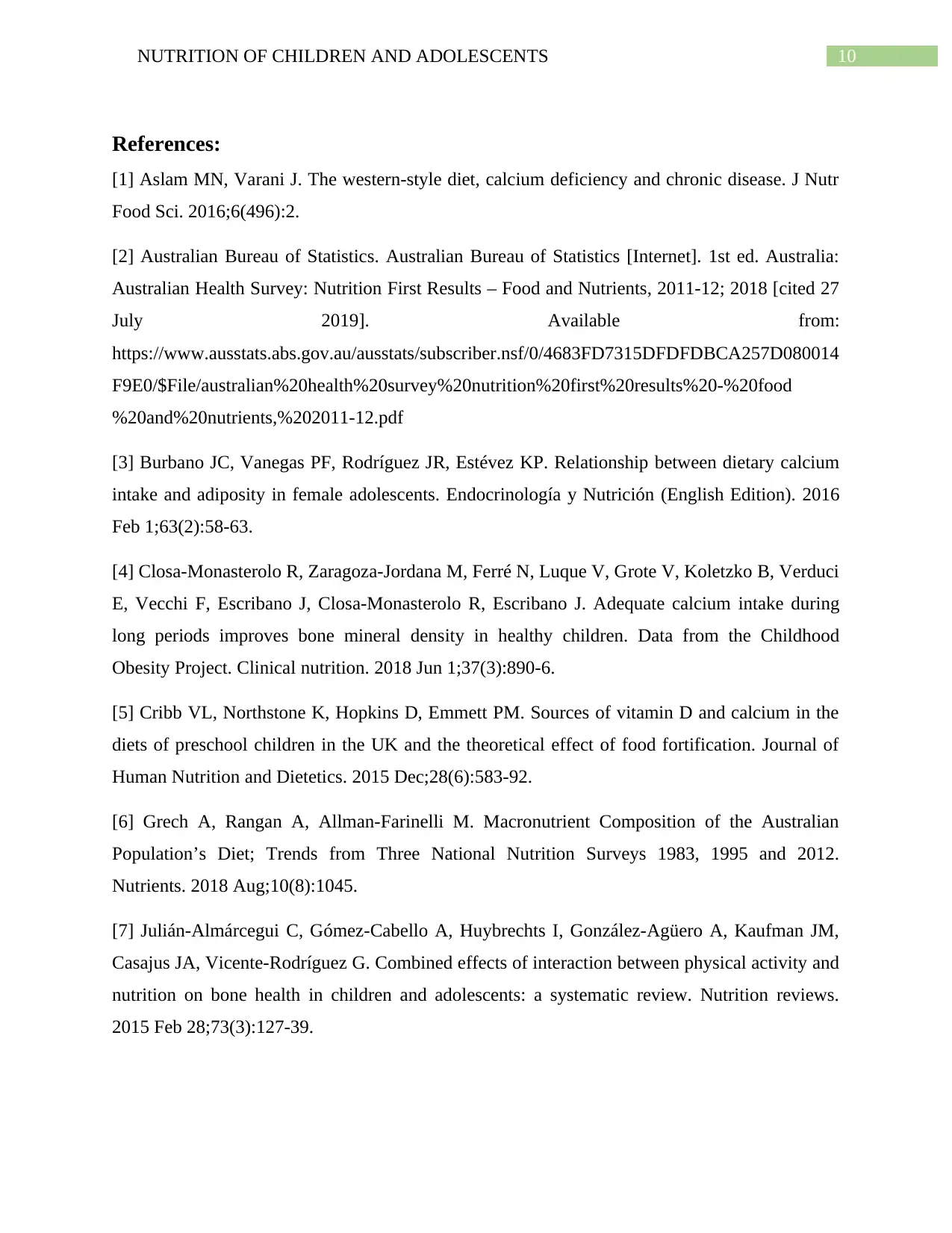
10NUTRITION OF CHILDREN AND ADOLESCENTS
References:
[1] Aslam MN, Varani J. The western-style diet, calcium deficiency and chronic disease. J Nutr
Food Sci. 2016;6(496):2.
[2] Australian Bureau of Statistics. Australian Bureau of Statistics [Internet]. 1st ed. Australia:
Australian Health Survey: Nutrition First Results – Food and Nutrients, 2011-12; 2018 [cited 27
July 2019]. Available from:
https://www.ausstats.abs.gov.au/ausstats/subscriber.nsf/0/4683FD7315DFDFDBCA257D080014
F9E0/$File/australian%20health%20survey%20nutrition%20first%20results%20-%20food
%20and%20nutrients,%202011-12.pdf
[3] Burbano JC, Vanegas PF, Rodríguez JR, Estévez KP. Relationship between dietary calcium
intake and adiposity in female adolescents. Endocrinología y Nutrición (English Edition). 2016
Feb 1;63(2):58-63.
[4] Closa-Monasterolo R, Zaragoza-Jordana M, Ferré N, Luque V, Grote V, Koletzko B, Verduci
E, Vecchi F, Escribano J, Closa-Monasterolo R, Escribano J. Adequate calcium intake during
long periods improves bone mineral density in healthy children. Data from the Childhood
Obesity Project. Clinical nutrition. 2018 Jun 1;37(3):890-6.
[5] Cribb VL, Northstone K, Hopkins D, Emmett PM. Sources of vitamin D and calcium in the
diets of preschool children in the UK and the theoretical effect of food fortification. Journal of
Human Nutrition and Dietetics. 2015 Dec;28(6):583-92.
[6] Grech A, Rangan A, Allman-Farinelli M. Macronutrient Composition of the Australian
Population’s Diet; Trends from Three National Nutrition Surveys 1983, 1995 and 2012.
Nutrients. 2018 Aug;10(8):1045.
[7] Julián-Almárcegui C, Gómez-Cabello A, Huybrechts I, González-Agüero A, Kaufman JM,
Casajus JA, Vicente-Rodríguez G. Combined effects of interaction between physical activity and
nutrition on bone health in children and adolescents: a systematic review. Nutrition reviews.
2015 Feb 28;73(3):127-39.
References:
[1] Aslam MN, Varani J. The western-style diet, calcium deficiency and chronic disease. J Nutr
Food Sci. 2016;6(496):2.
[2] Australian Bureau of Statistics. Australian Bureau of Statistics [Internet]. 1st ed. Australia:
Australian Health Survey: Nutrition First Results – Food and Nutrients, 2011-12; 2018 [cited 27
July 2019]. Available from:
https://www.ausstats.abs.gov.au/ausstats/subscriber.nsf/0/4683FD7315DFDFDBCA257D080014
F9E0/$File/australian%20health%20survey%20nutrition%20first%20results%20-%20food
%20and%20nutrients,%202011-12.pdf
[3] Burbano JC, Vanegas PF, Rodríguez JR, Estévez KP. Relationship between dietary calcium
intake and adiposity in female adolescents. Endocrinología y Nutrición (English Edition). 2016
Feb 1;63(2):58-63.
[4] Closa-Monasterolo R, Zaragoza-Jordana M, Ferré N, Luque V, Grote V, Koletzko B, Verduci
E, Vecchi F, Escribano J, Closa-Monasterolo R, Escribano J. Adequate calcium intake during
long periods improves bone mineral density in healthy children. Data from the Childhood
Obesity Project. Clinical nutrition. 2018 Jun 1;37(3):890-6.
[5] Cribb VL, Northstone K, Hopkins D, Emmett PM. Sources of vitamin D and calcium in the
diets of preschool children in the UK and the theoretical effect of food fortification. Journal of
Human Nutrition and Dietetics. 2015 Dec;28(6):583-92.
[6] Grech A, Rangan A, Allman-Farinelli M. Macronutrient Composition of the Australian
Population’s Diet; Trends from Three National Nutrition Surveys 1983, 1995 and 2012.
Nutrients. 2018 Aug;10(8):1045.
[7] Julián-Almárcegui C, Gómez-Cabello A, Huybrechts I, González-Agüero A, Kaufman JM,
Casajus JA, Vicente-Rodríguez G. Combined effects of interaction between physical activity and
nutrition on bone health in children and adolescents: a systematic review. Nutrition reviews.
2015 Feb 28;73(3):127-39.
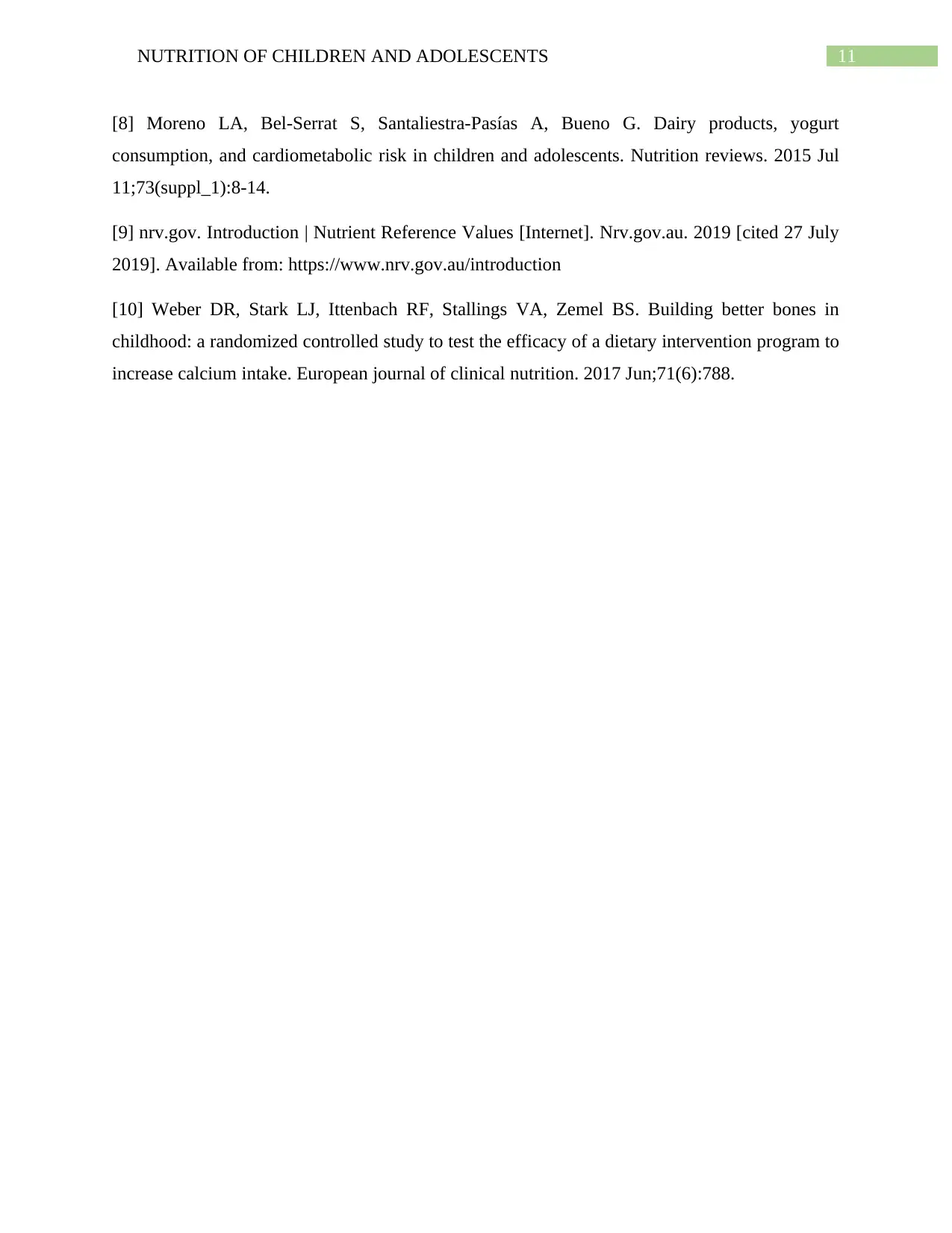
11NUTRITION OF CHILDREN AND ADOLESCENTS
[8] Moreno LA, Bel-Serrat S, Santaliestra-Pasías A, Bueno G. Dairy products, yogurt
consumption, and cardiometabolic risk in children and adolescents. Nutrition reviews. 2015 Jul
11;73(suppl_1):8-14.
[9] nrv.gov. Introduction | Nutrient Reference Values [Internet]. Nrv.gov.au. 2019 [cited 27 July
2019]. Available from: https://www.nrv.gov.au/introduction
[10] Weber DR, Stark LJ, Ittenbach RF, Stallings VA, Zemel BS. Building better bones in
childhood: a randomized controlled study to test the efficacy of a dietary intervention program to
increase calcium intake. European journal of clinical nutrition. 2017 Jun;71(6):788.
[8] Moreno LA, Bel-Serrat S, Santaliestra-Pasías A, Bueno G. Dairy products, yogurt
consumption, and cardiometabolic risk in children and adolescents. Nutrition reviews. 2015 Jul
11;73(suppl_1):8-14.
[9] nrv.gov. Introduction | Nutrient Reference Values [Internet]. Nrv.gov.au. 2019 [cited 27 July
2019]. Available from: https://www.nrv.gov.au/introduction
[10] Weber DR, Stark LJ, Ittenbach RF, Stallings VA, Zemel BS. Building better bones in
childhood: a randomized controlled study to test the efficacy of a dietary intervention program to
increase calcium intake. European journal of clinical nutrition. 2017 Jun;71(6):788.
⊘ This is a preview!⊘
Do you want full access?
Subscribe today to unlock all pages.

Trusted by 1+ million students worldwide
1 out of 12
Related Documents
Your All-in-One AI-Powered Toolkit for Academic Success.
+13062052269
info@desklib.com
Available 24*7 on WhatsApp / Email
![[object Object]](/_next/static/media/star-bottom.7253800d.svg)
Unlock your academic potential
Copyright © 2020–2025 A2Z Services. All Rights Reserved. Developed and managed by ZUCOL.





